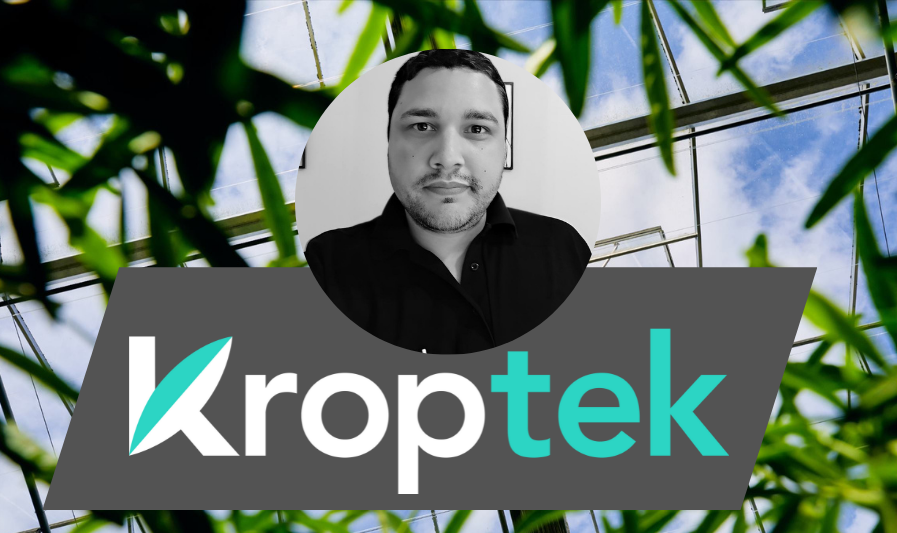Antoine Charvin is Kroptek’s Lead Application Engineer. With a decade of experience in multiple lighting sectors, he brings a wealth of knowledge to the company. Marrying an extensive understanding of electrical engineering with the ins and outs of plant science. In this interview, we explore what it’s been like to move into horticultural lighting, what it’s like working for an Agtech start-up, and what he’s excited about going forward.
Can you tell me a little bit about your background before you got into horticultural lighting?
Before joining Kroptek three years ago I worked in traditional lighting for ten years. I worked in a number of different lighting sectors and projects. I went from starting in a small lighting consultancy in Paris where art was at the centre of each project to working on multiple projects across the UK, Europe, and the Middle East, such as the IMAX in London and the Port de Bayonne in France. Horticultural lighting was the only field I was yet to work in, so I took the chance to join a young and dynamic start-up with a focus on R&D.
You previously worked in a number of more traditional lighting sectors; what was the transition into horticultural lighting like?
One of the biggest challenges of transferring from traditional lighting into horticulture lighting is the need to re-learn lighting from scratch. Whilst the lights themselves and the general rules are fundamentally the same, their user, in this case, humans vs. plants, have vastly different needs. As a result, the core units and spectrums used differ greatly from those used in commercial lighting and you need to start accommodating needs that are totally absent from commercial lighting. On top of these changes, each type of plant has different needs, and the learning curve can be very steep at times. We are always adapting our spectrums and approaches but especially when we are asked to provide lighting for crops we have not previously worked with. So even once you have the basics covered, you have to keep an open mind as there is always something new to learn.
What encouraged you to join Kroptek and what has it been like working for a start-up?
I decided to join Kroptek for multiple reasons. Firstly, we had similar mindsets about global food consumption, sustainability, and what the world needs to improve to feed the planet in the next 10-20 years. I’d like to think I am making a difference, maybe a small one but a difference, nonetheless. Secondly, Kroptek has always been very focused on R&D with its relationship with many universities and research centres, and I have always had a keen interest in new technologies and the latest lighting trends. Finally, the dynamism of a start-up has always been something I was looking for.
Since then, working at Kroptek allows me to not be stuck in doing the same thing over and over, each day is drastically different which makes the job exciting to me. I get involved in most of the projects from the initial meetings and on-site visits to the lighting proposals and development of bespoke solutions to fit the needs of the project. I am also involved in technical advice to clients, aftersales services and anything that requires my help. This means there is no day like another, and it is what I have always looked for in a job.
What do you find most exciting about the industry Kroptek is in?
I come from a rural French town where traditional farming is at the core of everything, however, more sustainable farming will be an absolute necessity in the near future to reduce water and food waste, CO2 emissions, and so on. I firmly believe that Kroptek is contributing to a more sustainable farming and a circular food production system.
What’s next for you and Kroptek?
Lighting, and especially the LED industry, is always evolving, so a newer and better technology might come into play at any time. I always enjoy developing new products and improving our existing range. For example, the complete development, from start to finish, of our “Living Wall” light fixture was very exciting. The combination of different lighting experiences and knowledge, in this case, architectural and horticultural, to solve all the issues our clients were experiencing was very exciting. Also, the widespread use of UV-C lighting to eliminate pesticides and fungicides is another development I’m excited to look into next. Finally, more partnerships and more relationships with like-minded companies. These are only some of the next steps for Kroptek and the lighting industry and whatever comes our way I am looking forward to being a part of it.
If you’d like to get in touch with Antoine to discuss a horticultural lighting project you can get in touch here.

